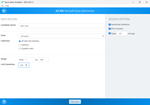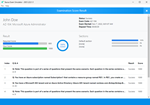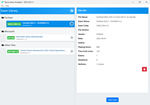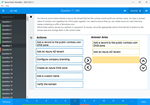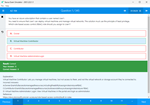Download Salesforce Certified AI Specialist.AI-Specialist.VCEplus.2024-10-20.45q.tqb
| Vendor: | Salesforce |
| Exam Code: | AI-Specialist |
| Exam Name: | Salesforce Certified AI Specialist |
| Date: | Oct 20, 2024 |
| File Size: | 228 KB |
How to open TQB files?
Files with TQB (Taurus Question Bank) extension can be opened by Taurus Exam Studio.
Purchase
Coupon: TAURUSSIM_20OFF
Discount: 20%
Demo Questions
Question 1
Universal Containers' data science team is hosting a generative large language model (LLM) on Amazon Web Services (AWS).
What should the team use to access externally-hosted models in the Salesforce Platform?
- Model Builder
- App Builder
- Copilot Builder
Correct answer: A
Explanation:
To access externally-hosted models, such as a large language model (LLM) hosted on AWS, the Model Builder in Salesforce is the appropriate tool. Model Builder allows teams to integrate and deploy external AI models into the Salesforce platform, making it possible to leverage models hosted outside of Salesforce infrastructure while still benefiting from the platform's native AI capabilities.Option B, App Builder, is primarily used to build and configure applications in Salesforce, not to integrate AI models.Option C, Copilot Builder, focuses on building assistant-like tools rather than integrating external AI models.Model Builder enables seamless integration with external systems and models, allowing Salesforce users to use external LLMs for generating AI-driven insights and automation.Salesforce AI SpecialistReference: For more details, check the Model Builder guide here: https://help.salesforce.com/s/articleView?id=sf.model_builder_external_models.htm To access externally-hosted models, such as a large language model (LLM) hosted on AWS, the Model Builder in Salesforce is the appropriate tool. Model Builder allows teams to integrate and deploy external AI models into the Salesforce platform, making it possible to leverage models hosted outside of Salesforce infrastructure while still benefiting from the platform's native AI capabilities.
Option B, App Builder, is primarily used to build and configure applications in Salesforce, not to integrate AI models.
Option C, Copilot Builder, focuses on building assistant-like tools rather than integrating external AI models.
Model Builder enables seamless integration with external systems and models, allowing Salesforce users to use external LLMs for generating AI-driven insights and automation.
Salesforce AI Specialist
Reference: For more details, check the Model Builder guide here: https://help.salesforce.com/s/articleView?id=sf.model_builder_external_models.htm
Question 2
How does the Einstein Trust Layer ensure that sensitive data is protected while generating useful and meaningful responses?
- Masked data will be de-masked during response journey.
- Masked data will be de-masked during request journey.
- Responses that do not meet the relevance threshold will be automatically rejected.
Correct answer: A
Explanation:
The Einstein Trust Layer ensures that sensitive data is protected while generating useful and meaningful responses by masking sensitive data before it is sent to the Large Language Model (LLM) and then de-masking it during the response journey.How It Works:Data Masking in the Request Journey:Sensitive Data Identification: Before sending the prompt to the LLM, the Einstein Trust Layer scans the input for sensitive data, such as personally identifiable information (PII), confidential business information, or any other data deemed sensitive.Masking Sensitive Data: Identified sensitive data is replaced with placeholders or masks. This ensures that the LLM does not receive any raw sensitive information, thereby protecting it from potential exposure.Processing by the LLM:Masked Input: The LLM processes the masked prompt and generates a response based on the masked data.No Exposure of Sensitive Data: Since the LLM never receives the actual sensitive data, there is no risk of it inadvertently including that data in its output.De-masking in the Response Journey:Re-insertion of Sensitive Data: After the LLM generates a response, the Einstein Trust Layer replaces the placeholders in the response with the original sensitive data.Providing Meaningful Responses: This de-masking process ensures that the final response is both meaningful and complete, including the necessary sensitive information where appropriate.Maintaining Data Security: At no point is the sensitive data exposed to the LLM or any unintended recipients, maintaining data security and compliance.Why Option A is Correct:De-masking During Response Journey: The de-masking process occurs after the LLM has generated its response, ensuring that sensitive data is only reintroduced into the output at the final stage, securely and appropriately.Balancing Security and Utility: This approach allows the system to generate useful and meaningful responses that include necessary sensitive information without compromising data security.Why Options B and C are Incorrect:Option B (Masked data will be de-masked during request journey):Incorrect Process: De-masking during the request journey would expose sensitive data before it reaches the LLM, defeating the purpose of masking and compromising data security.Option C (Responses that do not meet the relevance threshold will be automatically rejected):Irrelevant to Data Protection: While the Einstein Trust Layer does enforce relevance thresholds to filter out inappropriate or irrelevant responses, this mechanism does not directly relate to the protection of sensitive data. It addresses response quality rather than data security.Salesforce AI Specialist Documentation - Einstein Trust Layer Overview:Explains how the Trust Layer masks sensitive data in prompts and re-inserts it after LLM processing to protect data privacy.Salesforce Help - Data Masking and De-masking Process:Details the masking of sensitive data before sending to the LLM and the de-masking process during the response journey.Salesforce AI Specialist Exam Guide - Security and Compliance in AI:Outlines the importance of data protection mechanisms like the Einstein Trust Layer in AI implementations.Conclusion:The Einstein Trust Layer ensures sensitive data is protected by masking it before sending any prompts to the LLM and then de-masking it during the response journey. This process allows Salesforce to generate useful and meaningful responses that include necessary sensitive information without exposing that data during the AI processing, thereby maintaining data security and compliance. The Einstein Trust Layer ensures that sensitive data is protected while generating useful and meaningful responses by masking sensitive data before it is sent to the Large Language Model (LLM) and then de-masking it during the response journey.
How It Works:
Data Masking in the Request Journey:
Sensitive Data Identification: Before sending the prompt to the LLM, the Einstein Trust Layer scans the input for sensitive data, such as personally identifiable information (PII), confidential business information, or any other data deemed sensitive.
Masking Sensitive Data: Identified sensitive data is replaced with placeholders or masks. This ensures that the LLM does not receive any raw sensitive information, thereby protecting it from potential exposure.
Processing by the LLM:
Masked Input: The LLM processes the masked prompt and generates a response based on the masked data.
No Exposure of Sensitive Data: Since the LLM never receives the actual sensitive data, there is no risk of it inadvertently including that data in its output.
De-masking in the Response Journey:
Re-insertion of Sensitive Data: After the LLM generates a response, the Einstein Trust Layer replaces the placeholders in the response with the original sensitive data.
Providing Meaningful Responses: This de-masking process ensures that the final response is both meaningful and complete, including the necessary sensitive information where appropriate.
Maintaining Data Security: At no point is the sensitive data exposed to the LLM or any unintended recipients, maintaining data security and compliance.
Why Option A is Correct:
De-masking During Response Journey: The de-masking process occurs after the LLM has generated its response, ensuring that sensitive data is only reintroduced into the output at the final stage, securely and appropriately.
Balancing Security and Utility: This approach allows the system to generate useful and meaningful responses that include necessary sensitive information without compromising data security.
Why Options B and C are Incorrect:
Option B (Masked data will be de-masked during request journey):
Incorrect Process: De-masking during the request journey would expose sensitive data before it reaches the LLM, defeating the purpose of masking and compromising data security.
Option C (Responses that do not meet the relevance threshold will be automatically rejected):
Irrelevant to Data Protection: While the Einstein Trust Layer does enforce relevance thresholds to filter out inappropriate or irrelevant responses, this mechanism does not directly relate to the protection of sensitive data. It addresses response quality rather than data security.
Salesforce AI Specialist Documentation - Einstein Trust Layer Overview:
Explains how the Trust Layer masks sensitive data in prompts and re-inserts it after LLM processing to protect data privacy.
Salesforce Help - Data Masking and De-masking Process:
Details the masking of sensitive data before sending to the LLM and the de-masking process during the response journey.
Salesforce AI Specialist Exam Guide - Security and Compliance in AI:
Outlines the importance of data protection mechanisms like the Einstein Trust Layer in AI implementations.
Conclusion:
The Einstein Trust Layer ensures sensitive data is protected by masking it before sending any prompts to the LLM and then de-masking it during the response journey. This process allows Salesforce to generate useful and meaningful responses that include necessary sensitive information without exposing that data during the AI processing, thereby maintaining data security and compliance.
Question 3
Universal Containers (UC) wants to enable its sales team to get insights into product and competitor names mentioned during calls.
How should UC meet this requirement?
- Enable Einstein Conversation Insights, assign permission sets, define recording managers, and customize insights with up to 50 competitor names.
- Enable Einstein Conversation Insights, connect a recording provider, assign permission sets, and customize insights with up to 25 products.
- Enable Einstein Conversation Insights, enable sales recording, assign permission sets, and customize insights with up to 50 products.
Correct answer: C
Explanation:
To provide the sales team with insights into product and competitor names mentioned during calls, Universal Containers should:Enable Einstein Conversation Insights: Activates the feature that analyzes call recordings for valuable insights.Enable Sales Recording: Allows calls to be recorded within Salesforce without needing an external recording provider.Assign Permission Sets: Grants the necessary permissions to sales team members to access and utilize conversation insights.Customize Insights: Configure the system to track mentions of up to 50 products and 50 competitors, providing tailored insights relevant to the organization's needs.Option C accurately reflects these steps. Option A mentions defining recording managers but omits enabling sales recording within Salesforce. Option B suggests connecting a recording provider and limits customization to 25 products, which does not fully meet UC's requirements.Salesforce AI Specialist Documentation - Setting Up Einstein Conversation Insights: Provides instructions on enabling conversation insights and sales recording.Salesforce Help - Customizing Conversation Insights: Details how to customize insights with up to 50 products and competitors.Salesforce AI Specialist Exam Guide: Outlines best practices for implementing AI features like Einstein Conversation Insights in a sales context.========================= To provide the sales team with insights into product and competitor names mentioned during calls, Universal Containers should:
Enable Einstein Conversation Insights: Activates the feature that analyzes call recordings for valuable insights.
Enable Sales Recording: Allows calls to be recorded within Salesforce without needing an external recording provider.
Assign Permission Sets: Grants the necessary permissions to sales team members to access and utilize conversation insights.
Customize Insights: Configure the system to track mentions of up to 50 products and 50 competitors, providing tailored insights relevant to the organization's needs.
Option C accurately reflects these steps. Option A mentions defining recording managers but omits enabling sales recording within Salesforce. Option B suggests connecting a recording provider and limits customization to 25 products, which does not fully meet UC's requirements.
Salesforce AI Specialist Documentation - Setting Up Einstein Conversation Insights: Provides instructions on enabling conversation insights and sales recording.
Salesforce Help - Customizing Conversation Insights: Details how to customize insights with up to 50 products and competitors.
Salesforce AI Specialist Exam Guide: Outlines best practices for implementing AI features like Einstein Conversation Insights in a sales context.
=========================
Question 4
What is the role of the large language model (LLM) in executing an Einstein Copilot Action?
- Find similar requests and provide actions that need to be executed
- Identify the best matching actions and correct order of execution
- Determine a user's access and sort actions by priority to be executed
Correct answer: B
Explanation:
In Einstein Copilot, the role of the Large Language Model (LLM) is to analyze user inputs and identify the best matching actions that need to be executed. It uses natural language understanding to break down the user's request and determine the correct sequence of actions that should be performed.By doing so, the LLM ensures that the tasks and actions executed are contextually relevant and are performed in the proper order. This process provides a seamless, AI-enhanced experience for users by matching their requests to predefined Salesforce actions or flows.The other options are incorrect because:A mentions finding similar requests, which is not the primary role of the LLM in this context.C focuses on access and sorting by priority, which is handled more by security models and governance than by the LLM.Salesforce Einstein Documentation on Einstein Copilot ActionsSalesforce AI Documentation on Large Language Models In Einstein Copilot, the role of the Large Language Model (LLM) is to analyze user inputs and identify the best matching actions that need to be executed. It uses natural language understanding to break down the user's request and determine the correct sequence of actions that should be performed.
By doing so, the LLM ensures that the tasks and actions executed are contextually relevant and are performed in the proper order. This process provides a seamless, AI-enhanced experience for users by matching their requests to predefined Salesforce actions or flows.
The other options are incorrect because:
A mentions finding similar requests, which is not the primary role of the LLM in this context.
C focuses on access and sorting by priority, which is handled more by security models and governance than by the LLM.
Salesforce Einstein Documentation on Einstein Copilot Actions
Salesforce AI Documentation on Large Language Models
Question 5
A service agent is looking at a custom object that stores travel information. They recently received a weather alert and now need to cancel flights for the customers that are related with this itinerary. The service agent needs to review the Knowledge articles about canceling and rebooking the customer flights.
Which Einstein Copilot capability helps the agent accomplish this?
- Execute tasks based on available actions, answering questions using information from accessible Knowledge articles.
- Invoke a flow which makes a call to external data to create a Knowledge article.
- Generate a Knowledge article based off the prompts that the agent enters to create steps to cancel flights.
Correct answer: A
Explanation:
In this scenario, the Einstein Copilot capability that best helps the agent is its ability to execute tasks based on available actions and answer questions using data from Knowledge articles. Einstein Copilot can assist the service agent by providing relevant Knowledge articles on canceling and rebooking flights, ensuring that the agent has access to the correct steps and procedures directly within the workflow.This feature leverages the agent's existing context (the travel itinerary) and provides actionable insights or next steps from the relevant Knowledge articles to help the agent quickly resolve the customer's needs.The other options are incorrect:B refers to invoking a flow to create a Knowledge article, which is unrelated to the task of retrieving existing Knowledge articles.C focuses on generating Knowledge articles, which is not the immediate need for this situation where the agent requires guidance on existing procedures.Salesforce Documentation on Einstein CopilotTrailhead Module on Einstein for Service In this scenario, the Einstein Copilot capability that best helps the agent is its ability to execute tasks based on available actions and answer questions using data from Knowledge articles. Einstein Copilot can assist the service agent by providing relevant Knowledge articles on canceling and rebooking flights, ensuring that the agent has access to the correct steps and procedures directly within the workflow.
This feature leverages the agent's existing context (the travel itinerary) and provides actionable insights or next steps from the relevant Knowledge articles to help the agent quickly resolve the customer's needs.
The other options are incorrect:
B refers to invoking a flow to create a Knowledge article, which is unrelated to the task of retrieving existing Knowledge articles.
C focuses on generating Knowledge articles, which is not the immediate need for this situation where the agent requires guidance on existing procedures.
Salesforce Documentation on Einstein Copilot
Trailhead Module on Einstein for Service
Question 6
An AI Specialist has created a copilot custom action using flow as the reference action type. However, it is not delivering the expected results to the conversation preview, and therefore needs troubleshooting.
What should the AI Specialist do to identify the root cause of the problem?
- In Copilot Builder within the Dynamic Panel, turn on dynamic debugging to show the inputs and outputs.
- Copilot Builder within the Dynamic Panel, confirm selected action and observe the values in Input and Output sections.
- In Copilot Builder, verify the utterance entered by the user and review session event logs for debug information.
Correct answer: A
Explanation:
When troubleshooting a copilot custom action using flow as the reference action type, enabling dynamic debugging within Copilot Builder's Dynamic Panel is the most effective way to identify the root cause. By turning on dynamic debugging, the AI Specialist can see detailed logs showing both the inputs and outputs of the flow, which helps identify where the action might be failing or not delivering the expected results.Option B, confirming selected actions and observing the Input and Output sections, is useful for monitoring flow configuration but does not provide the deep diagnostic details available with dynamic debugging.Option C, verifying the user utterance and reviewing session event logs, could provide helpful context, but dynamic debugging is the primary tool for identifying issues with inputs and outputs in real time.Salesforce AI SpecialistReference: To explore more about dynamic debugging in Copilot Builder, see: https://help.salesforce.com/s/articleView?id=sf.copilot_custom_action_debugging.htm When troubleshooting a copilot custom action using flow as the reference action type, enabling dynamic debugging within Copilot Builder's Dynamic Panel is the most effective way to identify the root cause. By turning on dynamic debugging, the AI Specialist can see detailed logs showing both the inputs and outputs of the flow, which helps identify where the action might be failing or not delivering the expected results.
Option B, confirming selected actions and observing the Input and Output sections, is useful for monitoring flow configuration but does not provide the deep diagnostic details available with dynamic debugging.
Option C, verifying the user utterance and reviewing session event logs, could provide helpful context, but dynamic debugging is the primary tool for identifying issues with inputs and outputs in real time.
Salesforce AI Specialist
Reference: To explore more about dynamic debugging in Copilot Builder, see: https://help.salesforce.com/s/articleView?id=sf.copilot_custom_action_debugging.htm
Question 7
A support team handles a high volume of chat interactions and needs a solution to provide quick, relevant responses to customer inquiries.
Responses must be grounded in the organization's knowledge base to maintain consistency and accuracy.
Which feature in Einstein for Service should the support team use?
- Einstein Service Replies
- Einstein Reply Recommendations
- Einstein Knowledge Recommendations
Correct answer: B
Explanation:
The support team should use Einstein Reply Recommendations to provide quick, relevant responses to customer inquiries that are grounded in the organization's knowledge base. This feature leverages AI to recommend accurate and consistent replies based on historical interactions and the knowledge stored in the system, ensuring that responses are aligned with organizational standards.Einstein Service Replies (Option A) is focused on generating replies but doesn't have the same emphasis on grounding responses in the knowledge base.Einstein Knowledge Recommendations (Option C) suggests knowledge articles to agents, which is more about assisting the agent in finding relevant articles than providing automated or AI-generated responses to customers.Salesforce AI SpecialistReference: For more information on Einstein Reply Recommendations: https://help.salesforce.com/s/articleView?id=sf.einstein_reply_recommendations_overview.htm The support team should use Einstein Reply Recommendations to provide quick, relevant responses to customer inquiries that are grounded in the organization's knowledge base. This feature leverages AI to recommend accurate and consistent replies based on historical interactions and the knowledge stored in the system, ensuring that responses are aligned with organizational standards.
Einstein Service Replies (Option A) is focused on generating replies but doesn't have the same emphasis on grounding responses in the knowledge base.
Einstein Knowledge Recommendations (Option C) suggests knowledge articles to agents, which is more about assisting the agent in finding relevant articles than providing automated or AI-generated responses to customers.
Salesforce AI Specialist
Reference: For more information on Einstein Reply Recommendations: https://help.salesforce.com/s/articleView?id=sf.einstein_reply_recommendations_overview.htm
Question 8
Universal Containers implemented Einstein Copilot for its users.
One user complains that Einstein Copilot is not deleting activities from the past 7 days.
What is the reason for this issue?
- Einstein Copilot Delete Record Action permission is not associated to the user.
- Einstein Copilot does not have the permission to delete the user's records.
- Einstein Copilot does not support the Delete Record action.
Correct answer: C
Explanation:
Einstein Copilot currently supports various actions like creating and updating records but does not support the Delete Record action. Therefore, the user's request to delete activities from the past 7 days cannot be fulfilled using Einstein Copilot.Unsupported Action: The inability to delete records is due to the current limitations of Einstein Copilot's supported actions. It is designed to assist with tasks like data retrieval, creation, and updates, but for security and data integrity reasons, it does not facilitate the deletion of records.User Permissions: Even if the user has the necessary permissions to delete records within Salesforce, Einstein Copilot itself does not have the capability to execute delete operations.Salesforce AI Specialist Documentation - Einstein Copilot Supported Actions:Lists the actions that Einstein Copilot can perform, noting the absence of delete operations.Salesforce Help - Limitations of Einstein Copilot:Highlights current limitations, including unsupported actions like deleting records. Einstein Copilot currently supports various actions like creating and updating records but does not support the Delete Record action. Therefore, the user's request to delete activities from the past 7 days cannot be fulfilled using Einstein Copilot.
Unsupported Action: The inability to delete records is due to the current limitations of Einstein Copilot's supported actions. It is designed to assist with tasks like data retrieval, creation, and updates, but for security and data integrity reasons, it does not facilitate the deletion of records.
User Permissions: Even if the user has the necessary permissions to delete records within Salesforce, Einstein Copilot itself does not have the capability to execute delete operations.
Salesforce AI Specialist Documentation - Einstein Copilot Supported Actions:
Lists the actions that Einstein Copilot can perform, noting the absence of delete operations.
Salesforce Help - Limitations of Einstein Copilot:
Highlights current limitations, including unsupported actions like deleting records.
Question 9
Universal Containers' service team wants to customize the standard case summary response from Einstein Copilot.
What should the AI Specialist do to achieve this?
- Customize the standard Record Summary template for the Case object,
- Summarize the Case with a standard copilot action.
- Create a custom Record Summary prompt template for the Case object.
Correct answer: C
Explanation:
To customize the case summary response from Einstein Copilot, the AI Specialist should create a custom Record Summary prompt template for the Case object. This allows Universal Containers to tailor the way case data is summarized, ensuring the output aligns with specific business requirements or user preferences.Option A (customizing the standard Record Summary template) does not provide the flexibility required for deep customization.Option B (standard Copilot action) won't allow customization; it will only use default settings.Refer to Salesforce Prompt Builder documentation for guidance on creating custom templates for record summaries. To customize the case summary response from Einstein Copilot, the AI Specialist should create a custom Record Summary prompt template for the Case object. This allows Universal Containers to tailor the way case data is summarized, ensuring the output aligns with specific business requirements or user preferences.
Option A (customizing the standard Record Summary template) does not provide the flexibility required for deep customization.
Option B (standard Copilot action) won't allow customization; it will only use default settings.
Refer to Salesforce Prompt Builder documentation for guidance on creating custom templates for record summaries.
Question 10
Universal Containers wants to be able to detect with a high level confidence if content generated by a large language model (LLM) contains toxic language.
Which action should an Al Specialist take in the Trust Layer to confirm toxicity is being appropriately managed?
- Access the Toxicity Detection log in Setup and export all entries where isToxicityDetected is true.
- Create a flow that sends an email to a specified address each time the toxicity score from the response exceeds a predefined threshold.
- Create a Trust Layer audit report within Data Cloud that uses a toxicity detector type filter to display toxic responses and their respective scores.
Correct answer: C
Explanation:
To ensure that content generated by a large language model (LLM) is appropriately screened for toxic language, the AI Specialist should create a Trust Layer audit report within Data Cloud. By using the toxicity detector type filter, the report can display toxic responses along with their respective toxicity scores, allowing Universal Containers to monitor and manage any toxic content generated with a high level of confidence.Option C is correct because it enables visibility into toxic language detection within the Trust Layer and allows for auditing responses for toxicity.Option A suggests checking a toxicity detection log, but Salesforce provides more comprehensive options via the audit report.Option B involves creating a flow, which is unnecessary for toxicity detection monitoring.Salesforce Trust Layer Documentation: https://help.salesforce.com/s/articleView?id=sf.einstein_trust_layer_audit.htm To ensure that content generated by a large language model (LLM) is appropriately screened for toxic language, the AI Specialist should create a Trust Layer audit report within Data Cloud. By using the toxicity detector type filter, the report can display toxic responses along with their respective toxicity scores, allowing Universal Containers to monitor and manage any toxic content generated with a high level of confidence.
Option C is correct because it enables visibility into toxic language detection within the Trust Layer and allows for auditing responses for toxicity.
Option A suggests checking a toxicity detection log, but Salesforce provides more comprehensive options via the audit report.
Option B involves creating a flow, which is unnecessary for toxicity detection monitoring.
Salesforce Trust Layer Documentation: https://help.salesforce.com/s/articleView?id=sf.einstein_trust_layer_audit.htm
HOW TO OPEN VCE FILES
Use VCE Exam Simulator to open VCE files

HOW TO OPEN VCEX FILES
Use ProfExam Simulator to open VCEX files


ProfExam at a 20% markdown
You have the opportunity to purchase ProfExam at a 20% reduced price
Get Now!